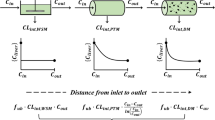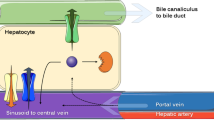Abstract
The pharmacokinetics of methylergometrine were investigated in the rat, with emphasis on the role of biliary excretion and enterohepatic recirculation in the overall disposition of the drug. A linked-rat model, where the bile from a rat receiving a constant rate of iv infusion of methylergometrine was allowed to flow into the duodenum of another rat, was used for the estimation of the degree of enterohepatic recirculation (EHC). The excretion of unchanged methylergometrine in the bile was estimated separately. Plasma protein binding and plasma-to-whole blood partitioning were also determined. Plasma clearance in control rats was 17.4 ± 0.7 ml/min × kg for iv bolus and 15.4 ± 0.7 ml/min × kg for iv infusion. The corresponding values in the bile-cannulated rats were significantly lower, 7.7 ± 0.4 and 8.7 ± 0.1 ml/min × kg, respectively. The lower clearance in the bile-cannulated rats was caused mainly by a lower free fraction in plasma, f u (0.11 ± 0.01), in this group compared with the control group (0.19 ± 0.0.03). The unbound volume of distribution at steady state (V ssu) was only 6.5 liters/kg in the bile-cannulated rats, compared to 14.7 liters/kg in control rats, suggesting that under steady-state conditions, more than 50% of the methylergometrine is conjugated or resides in the hepatobiliary loop, either as a conjugate or unchanged. The fraction of unchanged methylergometrine excreted in the bile was less than 0.3% of the given dose, while the fraction of the dose being reabsorbed during one cycle (f reabs) was 8.4 ± 6.3%. Thus, recirculation is due mainly to excretion of conjugates subsequently hydrolzyed in the GI tract prior to absorption. In spite of this relatively low degree of EHC, the terminal half-life was reduced from 186 ± 22 min in control rats to 79 ± 5 min in rats with an interrupted EHC. The data presented emphasize the role of enterohepatic recirculation in the disposition of a drug, i.e., even if the extent of EHC is relatively low, it may markedly effect the apparent volume of distribution, hence the terminal half-life of a drug.
Similar content being viewed by others
REFERENCES
H. Lin, K. C. Yeh, and D. E. Duggan. Drug Metab. Dispos. 13:321–326 (1985).
R. J. Parker, P. C. Holm, and P. Millburn. Xenobiotica 10:689–703 (1980).
T. A. Sutfin, M. Gabrielsson, and C. G. Regårdh. Xenobiotica 17:1203–1214 (1987).
I. Ichikawa, S. Ishida, Y. Sakiya, Y. Sawada, and M. Hanano. J. Pharm. Sci. 75:672–675 (1986).
R. C. Gill. J. Obstet. Gynecol. Br. Emp. 54:482–488 (1947).
U. Bredberg, G. S. Eyjolfsdottir, L. Paalzow, P. Tfelt-Hansen, and V. Tfelt-Hansen. Eur. J. Clin. Pharmacol. 30:75–77 (1986).
U. Bredberg and L. Paalzow. Drug Metab. Dispos. (in press).
E. Müller-Schweinitzer and C. Tapparelli. Cephalalgia 6:35–41 (1986).
H. B. Hucker, A. G. Zacchei, S. V. Cox, D. A. Brodie, and A. H. R. Cantwell. J. Pharmacol. Exp. Ther. 153:237–249 (1966).
C. Metzler and D. L. Weiner. PCNONLIN Users Guide, Statistical Consultants, Inc., Lexington, Ky.
C. M. Metzler. J. Pharm. Sci. 76:565–571 (1987).
H. Boxenbaum, S. Riegelman, and R. M. Elashoff. J. Pharmacokinet. Biopharm. 2:123–148 (1974).
C. D. Klaassen. Can. J. Physiol. Pharmacol. 52:334–348 (1974).
R. R. Scheline. Pharmacol. Rev. 25:451–523 (1973).
F. L. S. Tse, F. Ballard, and J. Skinn. J. Pharmacokin. Biopharmacokin. 10:455–461 (1982).
T. Niwaguchi, T. Inoue, and T. Sakai. Biochem. Pharmacol. 23:3063–3066 (1974).
Z. H. Siddik, R. D. Barnes, L. G. Dring, R. L. Smith, and R. T. Williams. Biochem. Soc. Trans. 3:290–292 (1975).
C. S. Marcus and F. W. Lengemann. J. Nutr. 76:179–182 (1962).
M. Yasuhara, J. Fujiwara, S. Kitade, H. Katayama, K. Okumora, and R. Hori. J. Pharmacol. Exp. Ther. 235:513–520 (1985).
R. K. Jain, L. E. Gerlowski, J. M. Weissbrod, J. Wang, and N. Pierson Jr. Ann. Biomed. Eng. 9:347 (1982).
G. R. Wilkinson and D. G. Shand. Clin. Pharmacol. Ther. 18:377–390 (1975).
Author information
Authors and Affiliations
Rights and permissions
About this article
Cite this article
Bredberg, U., Paalzow, L. Pharmacokinetics of Methylergometrine in the Rat: Evidence for Enterohepatic Recirculation by a Linked-Rat Model. Pharm Res 7, 14–20 (1990). https://doi.org/10.1023/A:1015871122537
Issue Date:
DOI: https://doi.org/10.1023/A:1015871122537




